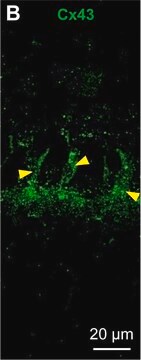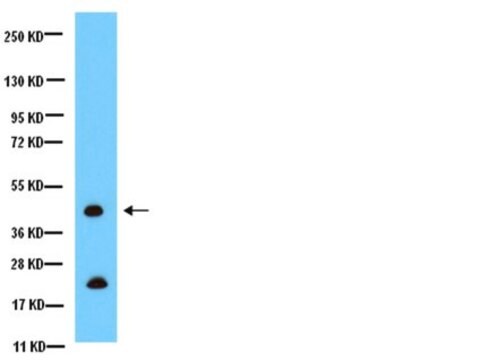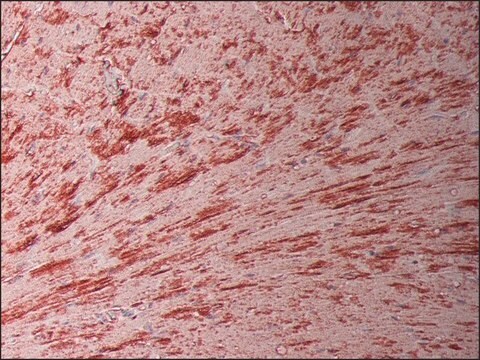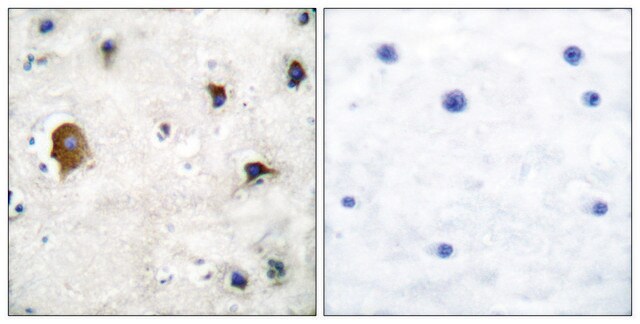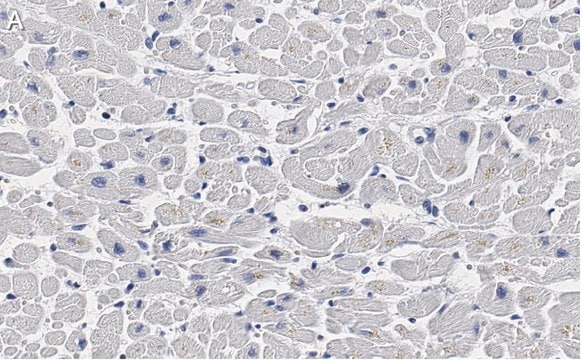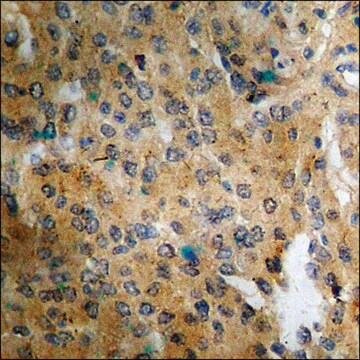MABT901
Anti-Connexin 43 Antibody, C-terminal Antibody, clone P4G9
clone P4G9, from mouse
Synonyme(s) :
Gap junction alpha-1 protein, CX43, Gap junction 43 kDa heart protein
About This Item
Produits recommandés
Source biologique
mouse
Niveau de qualité
Forme d'anticorps
purified immunoglobulin
Type de produit anticorps
primary antibodies
Clone
P4G9, monoclonal
Espèces réactives
mouse, human, rat
Réactivité de l'espèce (prédite par homologie)
guinea pig (based on 100% sequence homology), canine (based on 100% sequence homology), rabbit (based on 100% sequence homology), hamster (based on 100% sequence homology), porcine (based on 100% sequence homology), bovine (based on 100% sequence homology), rhesus monkey (based on 100% sequence homology)
Technique(s)
immunocytochemistry: suitable
immunofluorescence: suitable
immunohistochemistry: suitable (paraffin)
immunoprecipitation (IP): suitable
Isotype
IgG2aκ
Numéro d'accès NCBI
Numéro d'accès UniProt
Conditions d'expédition
ambient
Modification post-traductionnelle de la cible
unmodified
Informations sur le gène
bovine ... Gja1(281193)
dog ... Gja1(403418)
guinea pig ... Gja1(100379273)
human ... GJA1(2697)
mouse ... Gja1(14609)
rabbit ... Gja1(100008935)
rat ... Gja1(24392)
rhesus monkey ... Gja1(714344)
Description générale
Spécificité
Immunogène
Application
Immunofluorescence Analysis: A representative lot detected Connexin 43 in NRK cells (Courtesy of Joell Solan in Paul Lampe s Lab at the Fred Hutchinson Cancer Research Center, Seattle, WA).
Immunoprecipitation Analysis: A representative lot detected Connexin 43 in Immunoprecipitation applications (Sosinsky, G.E., et. al. (2007). Biochem J. 408(3):375-85).
Immunocytochemistry Analysis: A representative lot detected Connexin 43 in Immunocytochemistry applications (Norris, R.P., et. al. (2008). Development. 135(19):3229-38).
Immunocytochemistry Analysis: A representative lot detected Connexin 43 in Immunocytochemistry applications (Churko, J.M., et. al. (2010). Biochem J. 429(3):473-83).
Cell Structure
Qualité
Immunohistochemistry Analysis: A 1:50 dilution of this antibody detected Connexin 43 in human heart tissue.
Description de la cible
Forme physique
Stockage et stabilité
Autres remarques
Clause de non-responsabilité
Vous ne trouvez pas le bon produit ?
Essayez notre Outil de sélection de produits.
Code de la classe de stockage
12 - Non Combustible Liquids
Classe de danger pour l'eau (WGK)
WGK 1
Certificats d'analyse (COA)
Recherchez un Certificats d'analyse (COA) en saisissant le numéro de lot du produit. Les numéros de lot figurent sur l'étiquette du produit après les mots "Lot" ou "Batch".
Déjà en possession de ce produit ?
Retrouvez la documentation relative aux produits que vous avez récemment achetés dans la Bibliothèque de documents.
Notre équipe de scientifiques dispose d'une expérience dans tous les secteurs de la recherche, notamment en sciences de la vie, science des matériaux, synthèse chimique, chromatographie, analyse et dans de nombreux autres domaines..
Contacter notre Service technique